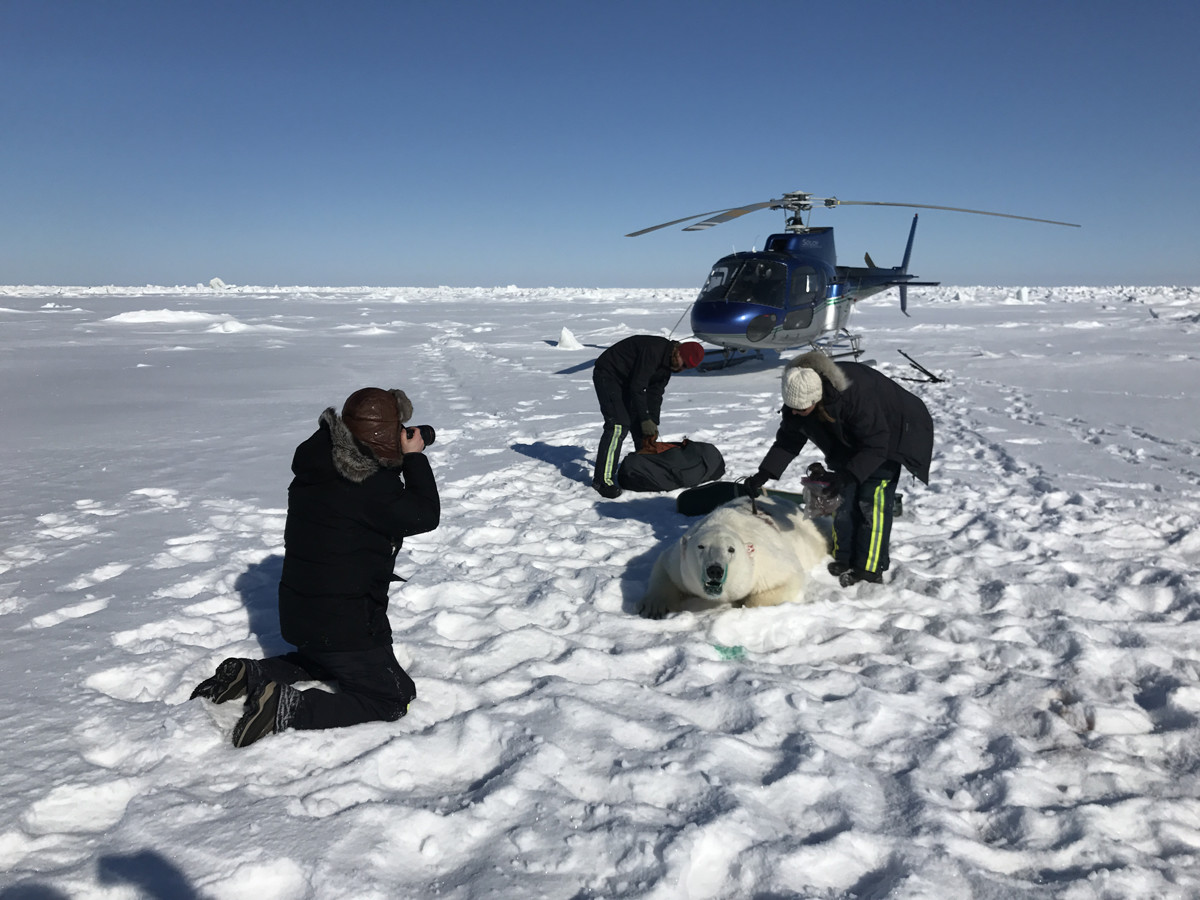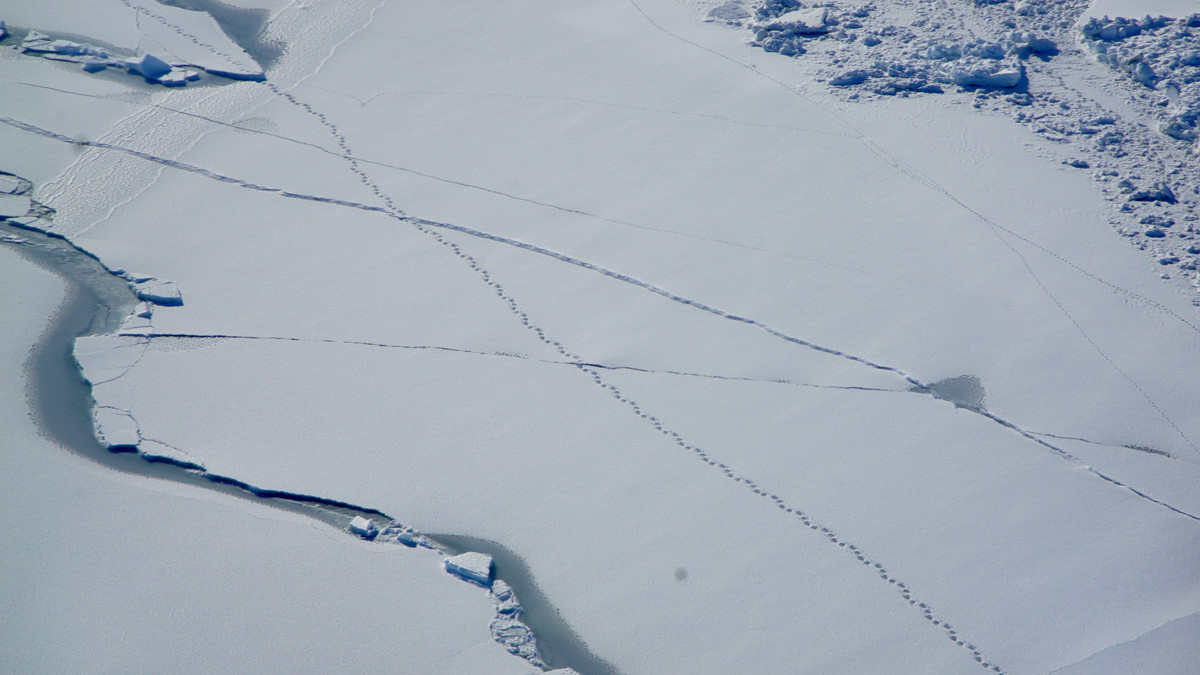How To Film A Polar Bear
As Science Friday’s Luke Groskin says, it starts with a terrifying helicopter ride.

Science Friday's Luke Groskin filming polar bear research. Photo by Johnathan Larabee.
This article originally appeared on Scientific American.
I’m standing 80 miles out on the frozen ocean, halfway between Alaska and Russia’s coasts, with a frigid 5°F wind blasting my exposed hands, trying to film researchers working over an anesthetized polar bear. I’ve got just an hour to get footage of United States Geological Survey scientist Karyn Rode and U.S. Fish and Wildlife Service biologist Michelle St. Martin at work before the 600-lb predator wakes, so I should be 100% concentrated on composing a close-up of the bear’s enormous head as they place an ear tag. Instead, I’m pondering, “How can anything hunt and survive out here?” As if on cue, my video camera dies with a stuttering click-grind as the cold shuts it down. I scramble back to our helicopter, retrieve my back-up camera and return to the researchers who have already moved on to taking a fat biopsy from the bear.
The researchers warned me again and again—they can’t stop to repeat a procedure. I need to refocus quickly. The animal grumbles and twitches as they collect a myriad of biometric data—weight, length, girth, skull width, as well blood, hair and tooth samples and the cold burns through nearly a dozen of my batteries. “Have they ever woken up on you?” I ask Rode, who I am profiling on this expedition. “Thankfully, no,” she replies as she begins packing up. I beg the researchers to pose for one more still photo. They oblige me but with the bear starting to rouse and lifting its head up, it’s time to go!
[Antarctica is getting green.]
Flashback to a year earlier, my co-producer Emily Driscoll and I are interviewing scientists to profile for Science Friday and the Howard Hughes Medical Institute’s video series Breakthrough: Portraits of Women in Science, when we speak with Rode about the challenging logistics of polar bear research “Our field season is only 6 weeks from mid-March to the end of April. That’s when the bears are out on the ice hunting, so that’s when we have to be ready to go. Unless there’s fog or blizzard conditions, we fly every day,” she cautions us. She then details the one-week window we can join her on Alaska’s Arctic coast, the special gear we’d need on site, and the hours of training we’d have to go through to fly in a government-operated helicopter, including a truly terrifying underwater egress course (my description, not hers) that simulates what it’s like to be inside of a rapidly capsizing helicopter.
It’s an intimidating list of requirements and preparations, one that doesn’t even guarantee we’d get to film Rode with the bears. Yet the more she explains how she takes basic biomarkers from a bear’s fur, blood, and fat to assess the bear’s age, nutrition, and health, the more intriguing her research becomes. That Rode and colleagues had been conducting this research for nearly a decade and were able to make clear-eyed assessments of the Chukchi Sea’s bear population make her story and the trip to film it well worth the risks.
[Meet the team of women who helped India get to Mars on the first try.]

A year later, I’m flying over the sea ice in the helicopter, trying to absorb and film the extreme austerity of the environment. A craggy white plain with small patches of glazed blue water, the sea ice seems a lifeless desert. As I try to capture this breathtaking vista, we bank hard to the right. “Got some bear tracks here,” the pilot remarks. Just as I line up the tracks in my camera’s viewfinder, the pilot turns left and rotates 90 degrees as we simultaneously dip 50 feet. “Looks like they go off this way,” he says casually. These swirling maneuvers continue for seven grueling hours or so as the pilot and researchers follow one set of tracks to another and I desperately try to film without puking. The day vanishes in a blink and we begin our return back to base camp at the Red Dog Mine’s port facilities. I feel I’ve wasted my time, having spent much of the trip feeling like a marionette being spun in a circle. I can’t wait to get out of the helicopter and onto solid ground. (I later found out that this was not an elaborate polar research hazing ritual but rather just a particularly difficult day of flying, even for the researchers.)
Two days later, armed with copious amounts of anti-nausea ginger gum, I’m ready for one last chance at filming the research. This time I stop filming the landscape and focus completely on following the tracks. The technique is immediately rewarding as I stay in sync with the movements of the helicopter as we follow mile after mile of tracks. It also hits me how much life I missed the first trip out. Written in the criss-crossing tracks of the bears, you see chases unfolding, hunting at the water’s edge, even breeding interactions. You also see the occasional red smudge in the snow—all that remains of the ring seal dinner.
Indeed, Karyn Rode’s research for the USGS has shown that the polar bears of the Chukchi Sea have just as much vitality as their tracks suggest. Despite grim forecasts of climate change and massive reductions in sea ice, these bears have yet to experience significant declines to their body condition or reproductive rates. Rode and her colleagues believe that the unique ecology of the Chukchi Sea, its shallow depth, and the accompanying populations of ocean-floor-feeding bearded seals and walrus have provided a nutritional buffer for the polar bears.
This theory is bolstered when examining the bears north of Alaska in the Beaufort Sea. Up there, the polar bears hunt over deeper, less abundant waters with more rapid sea-ice loss. Rode’s research has shown they’re facing declines in condition and abundance. It’s a nuanced picture for Alaska’s two populations of polar bears, one that hopefully fuels further monitoring as the seasonal ice continues to erode.
[As the Arctic warms, habitats are changing.]
Back in New York, as I begin to the edit the footage from my trip, I receive word from Rode and Michelle St. Martin that the tranquilized bear I filmed with them was one of the last of their season. The sea ice had broken up so much after my departure that it became too risky to sedate the bears near open water. Their field season was cut short one week early. It will take several more years of data collection to find out how rapid changes to the sea ice like these affect the bears of the Chukchi. Hopefully researchers like Rode will have enough time to get the data.
You can watch our film “Polar Bear Witness” and learn more about this research here:

Luke Groskin is Science Friday’s video producer. He’s on a mission to make you love spiders and other odd creatures.